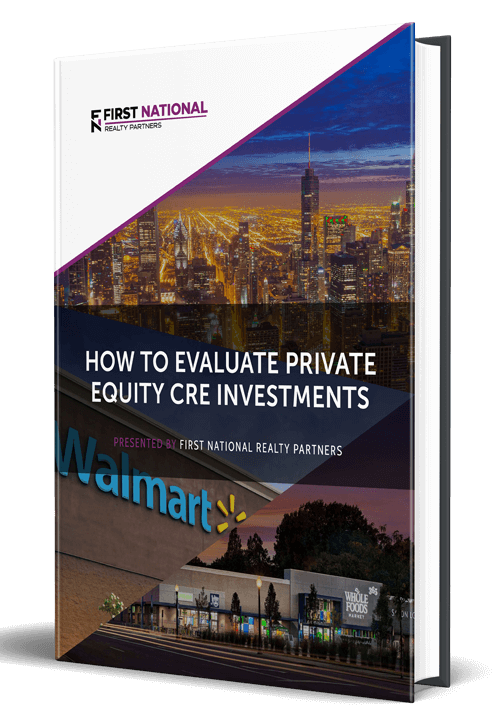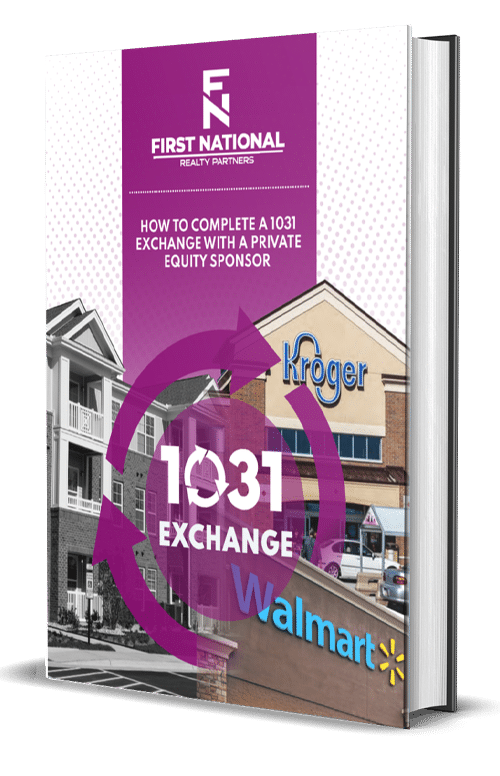When considering the purchase of a commercial real estate asset, all investors will use a property’s existing cash flows to create a “proforma” financial projection of future cash flows. The proforma, which includes allocations for income and expenses, serves as the basis for calculating the property’s potential return on investment.
A diligent real estate investor will use a number of different metrics to consider potential returns from a variety of perspectives before making an investment decision. One of the most important metrics in commercial real estate investing is the capitalization rate, or “cap rate” for short. Cap rate is a widely used but commonly misunderstood tool in the investment analysis toolbox.
This article provides an introduction to cap rates in commercial real estate, including the formula, general explanation, and tips on what is a good cap rate.
FNRP’s team of over 60 real estate professionals analyzes thousands of deals each month to identify exceptional opportunities for our investors. Accredited investors can click here to learn about FNRP’s offerings hand-picked by industry veterans.
Cap Rate in Real Estate: Definition and Formula
The cap rate is the rate of return that an investor could expect to receive on an all cash purchase of an investment property. The formula used to calculate cap rates is net operating income (NOI) divided by purchase price:

To understand the broader equation inputs, it is helpful to break down the components of a cap rate individually.
A property’s annual net operating income is its income less expenses, while the purchase price is the contemplated offer price. If the purchase price isn’t available when creating the projection, the appraised value or an estimate of the current market value can be used.
For example, if a property has a projected year-one net operating income of $100,000 and a sales price of $1,000,000, the implied cap rate is 10%. Put another way, if an investor paid $1,000,000 in cash for a property that produced $100,000 in annual income, they would earn a return of 10%.
Purchase Price Calculation
Another way that a cap rate can be used is to determine a property’s purchase price based on an investor’s return requirement. In this context, the equation can be rearranged as purchase price equals net operating income divided by required return or market cap rate:

In this use case, assume a real estate investor was looking at a property that produced $100,000 in net operating income annually, but was unsure what price they should offer for it. If they decided that they needed to earn a return of at least 8%, they could take the $100,000 in NOI and divide it by 8% to get a price of $1,250,000. Or, if the investor was considering the same property and knew that similar properties in the same market have recently sold for a cap rate of 9%, they would take the NOI of $100,000 and divide it by 9% to get a price of $1,111,000.
So, it can be seen that the cap rate is a dynamic and useful metric. While the formula used to calculate it is relatively simple, the intuition behind it is much more complex.
The Intuition Behind Cap Rate in Commercial Real Estate
Fundamentally, the cap rate is a measure of risk, specifically the risk that the income stream produced by a commercial property will be stable and long lasting. Lower cap rates signal lower risk so an investor will be required to pay a higher price as a result. Vice versa, a higher cap rate signals higher risk. So, in many ways the formula for the cap rate resembles that of a “perpetuity,” which is an income stream that theoretically goes on forever. The formula for value of perpetuity is annual income divided by expected rate of return:

In the value of perpetuity equation, the annual income produced by the perpetuity is similar to a property’s NOI and the expected rate of return is an estimate of the annual return on the property. To illustrate this point, assume that a property located in New York produces annual income of $100,000 and the expected rate of return (annually) is 8%. The perpetual value of this stream is $1.25 million. And, like the cap rate, the formula can be rearranged to find the expected rate of return if the value is known. If the price was $1.3 million and we know that the investment property would produce $100,000 in income annually, the implied annual return is 7.7%.
Variables that Drive the Cap Rate
The key difference between the cap rate formula and the perpetual value formula is that, in a commercial real estate property, the annual income stream is likely to change over time as tenants renew their leases and lease rates go up or down. Thus, the cap rate is driven by two variables:
- the expected return; and
- the growth rate of the property’s income.
Both of these variables are forward-looking and rely on the best estimates of the purchaser at the time of evaluation. As such, they can vary from one investor to another. Details on each are below.
1. Expected Returns
The expected return, also referred to as the required rate of return, is defined as the rate that an investor would expect to earn from an investment. Like other asset classes, the expected return from a property is directly related to the perceived risk associated with purchasing it. A relatively safe property with a single credit tenant on a 30-year lease has less perceived risk than a functionally obsolete office building that is 40% occupied. As a result, the required rate of return for the single-tenant property would be lower than for the office building.
What makes the expected return tricky to estimate is that it is: (1) relative; and (2) constantly changing. We consider it to be relative because we evaluate it in terms of its relationship with the interest rate on a 10-year Treasury Bond, which is sometimes referred to as the “risk free” rate. Here’s the logic: Treasury Bonds are backed by the full faith and credit of the United States government and the compensation for risk is always going to be relative to the rate on the 10-year Treasury Bond. For example, if the 10-year treasury rate was 5.00% and the expected return on the 40% occupied office building is 4%, we wouldn’t consider a purchase because there is no compensation premium for taking the additional risk. But, if the treasury was paying 5% and the property had an expected return of 10%, the deal may be more interesting because we’re being compensated for the risk of acquiring the real estate asset instead of the treasury bill(s).
As the treasury rate changes, expected return values follow suit, which has a material impact on the price an investor may be willing to pay for a property. For example, if the Treasury Bill rate was 5%, an investor would not be willing to accept a 5% return on a property investment. But, if the Treasury rate fell to .75%, that 5% return suddenly looks much more attractive. However, we know that a property’s income stream is not constant. It tends to increase over time, which is why the income growth rate is also a consideration.
2. Income Growth
One of the major advantages to investing in commercial real estate, like a retail center or a multifamily apartment building, is that rental income tends to grow over time. In commercial properties, it is common for a lease to mandate annual “rent bumps” of 1% to 3%. In strong markets, high demand can drive rental rates to grow even faster.
Income growth – or the expectation of it – is one of the most important data points to evaluate when analyzing cap rates because it drives material changes in property value. For example, assume that a property’s net operating income (NOI) in year one is $100,000 with a cap rate of 8% and a value of $1.25 million. If the income grows by 5% to $105,000 in year two and the cap rate stays the same, the property value is now $1.31 million.
To further illustrate this point, let’s assume that an investor is going to hold this same property for five years and that the NOI continues to grow by 5% annually while the cap rate stays the same. By the end of the holding period, the property will be worth significantly more than at the beginning and the investor will have earned a return from both the increasing income and the growth in property value.
In the example, the investor paid $1.25 million for the property and held the investment for five years. Because NOI grew by 5% each year, the “terminal value” or sales price is $1.64 million, assuming the same 8% cap rate. Given the actual income growth, the investor in this example has earned a strong profit.
Other Factors Driving Cap Rates
In addition to required rates of return and expected or actual growth rates in income, there are several other factors that may influence a property’s cap rate, and thus a property’s valuation.
1. Changes in Return & Growth Expectations
Changes in return and growth expectations can drive market cyclicality. When rental rates are growing and demand is high, the expectations for future growth are optimistic, leading to higher prices. Conversely, when rental rates are stagnant or falling and the expectation for growth is pessimistic, the required rate is higher and property prices are lower.
2. Financial Strength of Tenants
The financial strength of tenants, or their credit, drives cap rates to the extent that it drives certainty around lease payments and the income stream they produce. Tenants with significant financial strength represent a low risk for default on their leases and an investor would pay a higher price/lower cap rate for the relative security of a strong tenant. For tenants with marginal financial strength, an investor would demand a higher rate of return, leading to a lower price.
3. Remaining Lease Duration
Finally, remaining lease duration can affect cap rates due to its ability to impact certainty of future cash flow. A property with several tenants whose leases are close to expiring is more likely to experience income variability upon lease renewal than one with tenants whose leases have many years remaining until expiration.
How to Reduce Cap Rate Risk
It is a given that cap rates drive property value, but the truth is, there is no way of knowing what they are going to be in the future when contemplating a real estate investment. To protect against changes in cap rates, there are two things that can be done to reduce the risk associated with changes in them.
1. Increase Income
The first is to increase income, which can be achieved by either improving the property to justify higher rents or by just charging higher rents. Often, a fresh coat of paint, new carpet, lighting, landscaping, or refreshed common areas will increase an owner’s ability to charge more. On the same base of operating expenses, NOI – and thus property value – will improve. This capability to improve the market value of the asset will lead to a higher sale price at the exit.
2. Be Conservative When Underwriting the Property
The other way to mitigate cap rate risk is to be conservative when underwriting the property prior to purchase. Many investors will incorporate overly optimistic assumptions about the direction of cap rates over the term of ownership. At a minimum, the “exit cap” rate should be the same as the “entry” cap rate if not a little bit higher. If an investor is able to achieve their required returns under these conservative assumptions, they’ll be rewarded with a stronger than expected return in a favorable market.
What Is a Good Cap Rate in Commercial Real Estate?
After all of the explanation above, it is natural to ask, what is a good cap rate? The short answer is, it depends. Different investors have different return requirements and tolerance for risk so they are willing to pay different cap rates.
For commercial real estate, no cap rate that is better than another because cap rates are all relative to the perceived risk associated with acquiring the commercial property. Whether a cap rate is “good” is influenced by:
- the investment strategy,
- the investor’s risk tolerance,
- the asset class (office, multifamily, industrial, retail), and
- the expected return.
That said, generally, most investment grade commercial real estate rental properties tend to trade in the 4% – 12% cap rate range. If you’re interested in learning more about this topic, please read our article “What is a Good Cap Rate in Commercial Real Estate.”
Interested in Learning More?
Although important, cap rate calculation and its ensuing analysis shouldn’t be done in isolation by real estate investors. We use it as one of many tools in our chest to analyze the risk/return profile on investment of a potential investment.
First National Realty Partners is one of the country’s leading private equity commercial real estate investment firms. With an intentional focus on finding world-class, multi-tenanted assets well below intrinsic value, we seek to create superior long-term, risk-adjusted returns for our investors while creating strong economic assets for the communities we invest in.
If you’d like to learn more about our investment opportunities, contact us at (800) 605-4966 or info@fnrpusa.com for more information.






